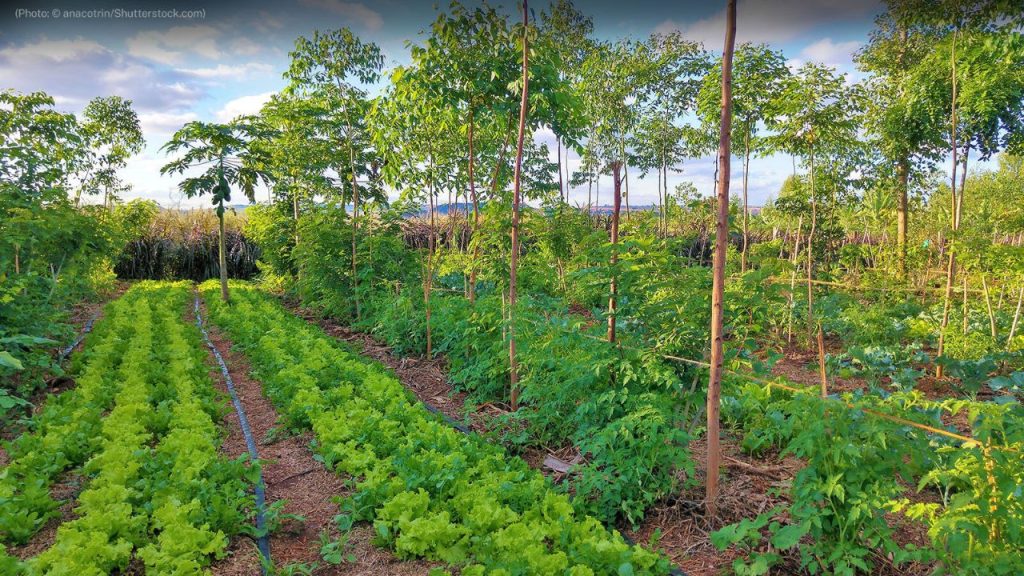The Benefits of Agroforestry
Agroforestry offers a multitude of benefits for both farmers and the environment. Some of the key advantages include:
1. Enhanced Biodiversity
Agroforestry systems support greater biodiversity by providing habitats for a wide range of species. The presence of trees and shrubs creates a more diverse ecosystem, attracting birds, insects, and small mammals. This increased biodiversity can lead to more robust ecosystems, with natural predators helping to control pests and pollinators boosting crop yields.
2. Improved Soil Health
Trees and shrubs in agroforestry systems contribute to healthier soils. Their roots help to stabilise the soil, reducing erosion and improving water infiltration. The leaf litter from trees adds organic matter to the soil, enhancing its structure and fertility. Over time, these improvements in soil health can lead to better crop productivity and resilience against extreme weather events.
3. Carbon Sequestration and Climate Resilience
Agroforestry plays a significant role in mitigating climate change by sequestering carbon dioxide from the atmosphere. Trees and shrubs act as carbon sinks, storing carbon in their biomass and soil. This process helps to reduce greenhouse gas concentrations and contributes to the UK’s climate targets. Additionally, agroforestry systems are more resilient to climate change, providing shade and shelter for crops and livestock, and reducing the risk of crop failure during extreme weather events.
4. Economic Diversification
Agroforestry offers farmers opportunities for economic diversification. In addition to traditional crops and livestock, farmers can harvest timber, fruits, nuts, and other tree-based products. This diversification can provide additional income streams, reducing reliance on a single crop or commodity and enhancing the financial stability of farms.
Agroforestry Practices in the UK
Various agroforestry practices are being adopted across the UK, each tailored to different farming systems and landscapes. Some of the most common practices include:
1. Silvopasture
Silvopasture involves the integration of trees and livestock grazing. Trees provide shade and shelter for animals, improving their welfare and productivity. In return, livestock help to manage undergrowth, reducing the risk of wildfires and promoting tree growth. This practice is particularly well-suited to upland and pastoral farming systems in the UK.
2. Alley Cropping
Alley cropping involves planting rows of trees or shrubs alongside crops. This practice allows farmers to grow high-value trees, such as fruit or nut trees, while still maintaining arable crop production. The trees can provide windbreaks, reducing soil erosion and protecting crops from the elements. Alley cropping is increasingly popular in lowland arable farming regions.
3. Riparian Buffers
Riparian buffers are strips of trees and vegetation planted along waterways. These buffers help to filter runoff, reducing the amount of sediment, nutrients, and pollutants entering rivers and streams. They also provide important habitats for wildlife and help to stabilise riverbanks, reducing erosion. Riparian buffers are commonly used in areas with watercourses, such as the river valleys of the UK.
4. Forest Farming
Forest farming involves cultivating crops under the canopy of a managed forest. This practice is particularly suitable for shade-tolerant crops, such as mushrooms, medicinal herbs, and ornamental plants. Forest farming allows farmers to make productive use of forested areas while maintaining the ecological functions of the forest.
Challenges to Agroforestry Adoption

While agroforestry offers numerous benefits, its adoption in the UK faces several challenges:
1. Knowledge and Awareness
Many farmers are unfamiliar with agroforestry practices and may lack the knowledge and skills needed to implement them effectively. There is a need for greater awareness and education on the benefits of agroforestry and how to integrate it into existing farming systems.
2. Initial Costs and Investment
Establishing agroforestry systems can require significant upfront investment in trees, fencing, and infrastructure. These costs can be a barrier for farmers, especially those with limited financial resources. However, grants and subsidies are available to support the establishment of agroforestry, and the long-term economic benefits often outweigh the initial costs.
3. Policy and Regulatory Barriers
Current agricultural policies and regulations in the UK are often designed for conventional farming systems and may not fully support agroforestry. For example, there may be restrictions on the types of trees that can be planted on agricultural land, or limited access to subsidies for agroforestry practices. Policy reform is needed to create a more enabling environment for agroforestry adoption.
4. Market Access for Agroforestry Products
Farmers may face challenges in accessing markets for agroforestry products, such as timber, fruits, and nuts. Developing strong supply chains and marketing channels for these products is essential to ensure that farmers can realise the economic benefits of agroforestry.
The Future of Agroforestry in the UK
Despite the challenges, agroforestry is poised for growth in the UK. Increasing awareness of the environmental and economic benefits of agroforestry, coupled with government support and policy reform, could accelerate its adoption. The UK’s commitment to climate action and sustainable farming practices provides a strong foundation for expanding agroforestry.
Looking ahead, collaborative efforts between farmers, researchers, policymakers, and industry stakeholders will be essential to unlock the full potential of agroforestry. By integrating trees and shrubs into agricultural landscapes, the UK can create more resilient, sustainable, and productive farming systems that benefit both people and the planet.
Conclusion: Agroforestry
Agroforestry is gaining ground in the UK as a sustainable farming practice that offers a range of environmental and economic benefits. By enhancing biodiversity, improving soil health, sequestering carbon, and providing opportunities for economic diversification, agroforestry can play a key role in the future of British agriculture. While challenges remain, the growing interest in agroforestry and the support of policy reforms and education efforts could see this practice become a cornerstone of sustainable farming in the UK.
